Submarine fault scarps in the Sea of Marmara pull-apart ... - HAL - IRD
Submarine fault scarps in the Sea of Marmara pull-apart ... - HAL - IRD
Submarine fault scarps in the Sea of Marmara pull-apart ... - HAL - IRD
Create successful ePaper yourself
Turn your PDF publications into a flip-book with our unique Google optimized e-Paper software.
Geochemistry<br />
Geophysics<br />
Geosystems G 3<br />
G 3 armijo et al.: sea <strong>of</strong> marmara <strong>pull</strong>-<strong>apart</strong> 10.1029/2004GC000896<br />
not be older than a century. The higher average<br />
sedimentation rates (up to 3 mm/yr) determ<strong>in</strong>ed<br />
over <strong>the</strong> whole Holocene period with <strong>the</strong> 14 C dates<br />
<strong>of</strong> wood fragments <strong>in</strong> <strong>the</strong> long cores (see Figure 3)<br />
also supports this <strong>in</strong>ference.<br />
[44] From <strong>the</strong> historical seismicity <strong>in</strong> <strong>the</strong> region<br />
[Ambraseys and F<strong>in</strong>kel, 1995; Ambraseys and<br />
Jackson, 2000], <strong>the</strong> large earthquakes <strong>of</strong> 1912 or<br />
<strong>of</strong> August 1766 are <strong>the</strong> only ones that can be<br />
considered consistent with <strong>the</strong> location, <strong>the</strong> rupture<br />
length and <strong>the</strong> slip associated with <strong>the</strong><br />
described submar<strong>in</strong>e break. However, only <strong>the</strong><br />
1912 event is consistent with <strong>the</strong> youthful morphology<br />
and <strong>the</strong> fast sedimentation rates <strong>in</strong> <strong>Marmara</strong>.<br />
Rema<strong>in</strong>s <strong>of</strong> ruptures <strong>of</strong> <strong>the</strong> 18th century<br />
earthquakes would probably be less <strong>in</strong>tact, less<br />
cont<strong>in</strong>uous and largely concealed by sediments.<br />
Regardless, <strong>the</strong>re appears to be fragmentary evidence<br />
for a penultimate event <strong>of</strong> similar size <strong>in</strong><br />
1766 on <strong>the</strong> SE Tekirdag <strong>fault</strong>, based on <strong>the</strong><br />
cumulative <strong>of</strong>fsets recorded on <strong>the</strong> visible <strong>scarps</strong><br />
(Figures 8b and 9d). That hypo<strong>the</strong>sis seems<br />
quantitatively consistent with <strong>the</strong> pattern <strong>of</strong> <strong>in</strong>tensity<br />
values assigned for <strong>the</strong> 5 August 1766<br />
earthquake [Parsons, 2004]. Our observations do<br />
not provide support for <strong>the</strong> <strong>in</strong>ference <strong>of</strong> seismic<br />
quiescence over <strong>the</strong> last 500 years <strong>in</strong> <strong>the</strong> northwest<br />
<strong>Sea</strong> <strong>of</strong> <strong>Marmara</strong> [Ambraseys and Jackson,<br />
2000].<br />
4.2. Previous Knowledge <strong>of</strong> <strong>the</strong> 1912<br />
Earthquake<br />
[45] The submar<strong>in</strong>e rupture <strong>in</strong> <strong>the</strong> northwest <strong>Sea</strong> <strong>of</strong><br />
<strong>Marmara</strong> must be compared with <strong>the</strong> relevant<br />
observations <strong>of</strong> <strong>the</strong> 1912 earthquake, which can<br />
be summarized as follows.<br />
[46] The 9 August 1912 Ganos earthquake produced<br />
widespread damage and considerable loss <strong>of</strong><br />
life. Surface disruptions along <strong>the</strong> Ganos <strong>fault</strong> were<br />
described <strong>in</strong> contemporary reports as ‘‘cracks’’<br />
[Macovei, 1912; Mihailovich, 1927; Sadi, 1912].<br />
No <strong>fault</strong> rupture was reported as such, but pictures<br />
<strong>of</strong> mole tracks and en echelon cracks clearly<br />
suggest prevalent right-lateral slip [Ambraseys<br />
and F<strong>in</strong>kel, 1987]. The significant normal slip <strong>of</strong><br />
3 m deduced by Ambraseys and F<strong>in</strong>kel [1987]<br />
appears to be mostly a secondary effect. The littoral<br />
to <strong>the</strong> southwest <strong>of</strong> where <strong>the</strong> Ganos <strong>fault</strong> enters<br />
<strong>the</strong> <strong>Sea</strong> <strong>of</strong> <strong>Marmara</strong> appears to have been slightly<br />
uplifted [Ambraseys and F<strong>in</strong>kel, 1987]. Such uplift<br />
is consistent with <strong>the</strong> transpressive deformation<br />
seen <strong>in</strong> submar<strong>in</strong>e <strong>scarps</strong> <strong>in</strong> <strong>the</strong> southwestern<br />
Tekirdag Bas<strong>in</strong>.<br />
[47] Various authors have <strong>of</strong>fered different isoseismal<br />
maps. The most recent and complete revision<br />
<strong>of</strong> macroseismic effects (estimates <strong>of</strong> local <strong>in</strong>tensities<br />
reportedly with<strong>in</strong> an error <strong>of</strong> ±1/2 degree <strong>of</strong><br />
<strong>in</strong>tensity) has been proposed by Ambraseys and<br />
F<strong>in</strong>kel [1987] and is based ma<strong>in</strong>ly on <strong>the</strong> precise<br />
observations by Mihailovich [1927]. Their two<br />
isoseismal maps can be compared <strong>in</strong> Figure 11.<br />
Ambraseys and F<strong>in</strong>kel [1987] deduced that coseismic<br />
<strong>fault</strong><strong>in</strong>g crossed all <strong>the</strong> land between <strong>the</strong> Gulf<br />
<strong>of</strong> Saros and <strong>Marmara</strong> with a total rupture length<br />
<strong>of</strong> 50 km. The rupture could well have extended<br />
westward some 20–30 km <strong>in</strong>to <strong>the</strong> Gulf <strong>of</strong> Saros.<br />
It is worth not<strong>in</strong>g that <strong>the</strong> macroseismic effects<br />
(with<strong>in</strong> estimated error) suggest that <strong>the</strong> rupture<br />
may have extended several tens <strong>of</strong> kilometers<br />
under <strong>the</strong> western <strong>Sea</strong> <strong>of</strong> <strong>Marmara</strong> although<br />
without constra<strong>in</strong><strong>in</strong>g precisely its term<strong>in</strong>ation<br />
(Figure 11).<br />
[48] Small tsunami waves suggest<strong>in</strong>g a possible<br />
submar<strong>in</strong>e extension <strong>of</strong> <strong>the</strong> rupture are reported<br />
along <strong>the</strong> shores <strong>of</strong> <strong>the</strong> <strong>Sea</strong> <strong>of</strong> <strong>Marmara</strong> at <strong>the</strong> time<br />
<strong>of</strong> <strong>the</strong> 1912 event but quantification <strong>of</strong> <strong>the</strong> phenomenon<br />
appears difficult [Mihailovich, 1927;<br />
Ambraseys and F<strong>in</strong>kel, 1987, 1991]. No tide gauge<br />
record is available. Part <strong>of</strong> <strong>the</strong> difficulty comes also<br />
from <strong>the</strong> scarcity <strong>of</strong> precise reports for an event that<br />
occurred by night (ma<strong>in</strong> shock at 01:29 UTH;<br />
about 03:30 local time).<br />
[49] An accurate <strong>in</strong>strumental location is not possible<br />
for <strong>the</strong> 1912 earthquake epicenter, due to <strong>the</strong><br />
primitiveness <strong>of</strong> seismic networks. However, a<br />
reliable surface-wave magnitude Ms 7.4 ± 0.3<br />
was calculated by Ambraseys and F<strong>in</strong>kel [1987]<br />
from teleseismic amplitudes from 23 Milne pendulum<br />
seismographs distributed worldwide and from<br />
amplitudes and periods from 23 mechanical <strong>in</strong>struments<br />
ma<strong>in</strong>ly from Europe. Hence <strong>the</strong> 1912 Ganos<br />
and <strong>the</strong> Mw 7.4 1999 Izmit earthquakes are <strong>of</strong><br />
similar size. The 1912 earthquake was followed by<br />
numerous aftershocks <strong>of</strong> which <strong>the</strong> largest occurred<br />
a month later (Ms 6.9; 13 September 1912)<br />
[Ambraseys and F<strong>in</strong>kel, 1987].<br />
[50] On <strong>the</strong> basis <strong>of</strong> field <strong>in</strong>vestigations carried<br />
out recently along <strong>the</strong> Ganos <strong>fault</strong>, Altunel et al.<br />
[2000] and Alt<strong>in</strong>ok et al. [2003] claim that some<br />
<strong>of</strong>fset features associated with <strong>the</strong> 1912 event can<br />
still be identified. Alt<strong>in</strong>ok et al. [2003] deduce a<br />
maximum right-lateral slip <strong>of</strong> 4.5 m ± 0.5 m and<br />
Altunel et al. [2004] describe a detailed coseismic<br />
slip distribution along <strong>the</strong> Ganos <strong>fault</strong> and identify<br />
three ma<strong>in</strong> segments. While <strong>the</strong> poor preservation<br />
<strong>of</strong> <strong>the</strong> features may cause misidentifications<br />
22 <strong>of</strong> 29




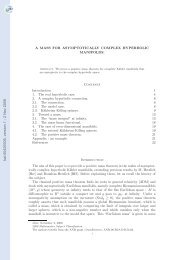
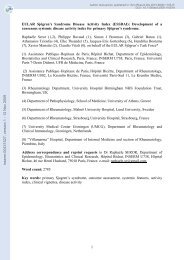
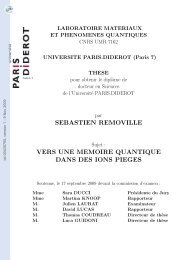
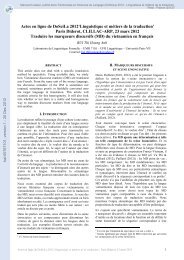
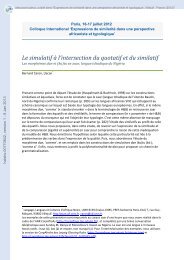
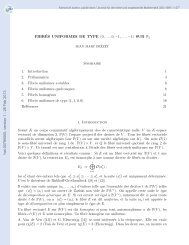
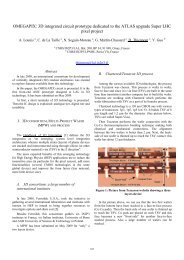
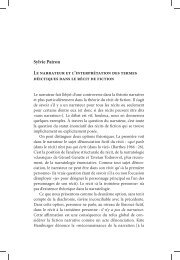
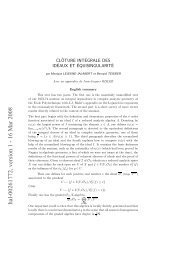
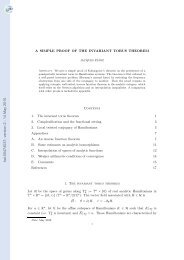

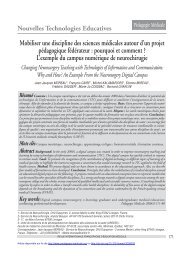

![[tel-00433556, v1] Relation entre Stress Oxydant et Homéostasie ...](https://img.yumpu.com/19233319/1/184x260/tel-00433556-v1-relation-entre-stress-oxydant-et-homeostasie-.jpg?quality=85)